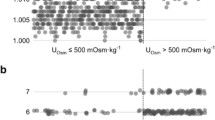Abstract
The measurement of urine concentration provides information concerning the kidney’s ability to appropriately respond to variations in fluid homeostasis. It also assists in the interpretation of other tests performed on the same urine specimen. The gold standard of estimating urinary concentration is the measurement of its osmolality; however, this procedure is not readily available to the practicing physician. Therefore, urine concentration is usually determined by measurement of its specific gravity (SG), which provides a fair estimate of urine osmolality. Over the years numerous tests have been developed to measure urine SG in a simple, quick, reliable and easily available method. These tests measure SG either directly (e.g., gravimetry) or by indirect methods (e.g., refractometry and reagent strip). All these tests have certain limitations based on their underlying physical principles. Specific gravity as measured by refractometry is influenced by proteinuria, such that for each 10 g/l protein the SG increases by 0.003. SG is also influenced by glucosuria such that it increases by approximately 0.002 per 10 g/l glucose when compared with urinary osmolality. Unlike osmolality, which is only affected by the number of particles, refractometry is affected by number, mass and chemical structure of the dissolved particles; hence large molecules like radiographic contrast or mannitol will increase SG relative to osmolality. The reagent strip is minimally affected by glucose, mannitol or radiographic contrast. However, it is affected by urinary pH such that only urine in the pH range of 7.0–7.5 can be correctly interpreted. The measurement of SG by reagent strip is based on the ionic strength of the urine and thus is significantly affected by the ionic composition of the urine and by proteins which have an electric charge in solution. In our experience, SG measured by the refractometer is consistently more accurate than the reagent strip. For the clinician who is interpreting urine SG results, it is important to be aware of these limitations and understand the reasons for possible potential errors of each particular method.
Similar content being viewed by others
Author information
Authors and Affiliations
Additional information
Received: 14 August 2000 / Revised: 24 November 2000 / Accepted: 27 November 2000
Rights and permissions
About this article
Cite this article
Chadha, V., Garg, U. & Alon, U. Measurement of urinary concentration: a critical appraisal of methodologies. Pediatr Nephrol 16, 374–382 (2001). https://doi.org/10.1007/s004670000551
Issue Date:
DOI: https://doi.org/10.1007/s004670000551




